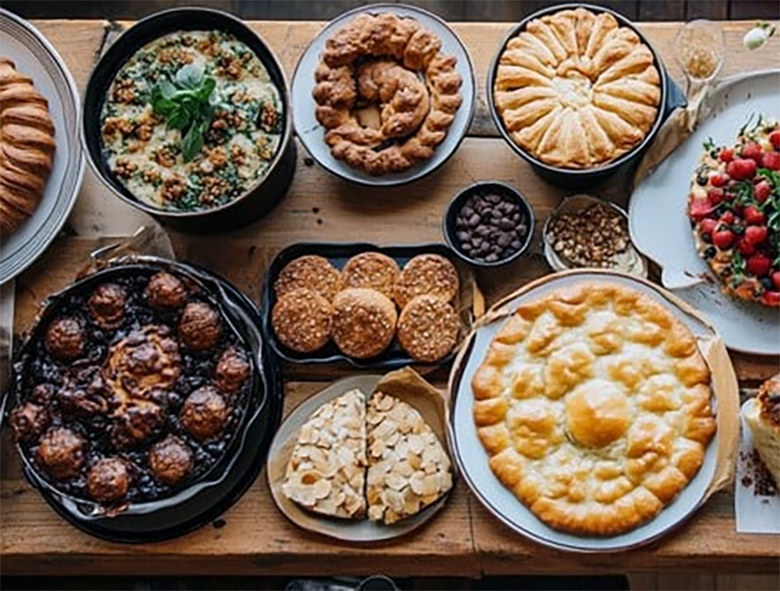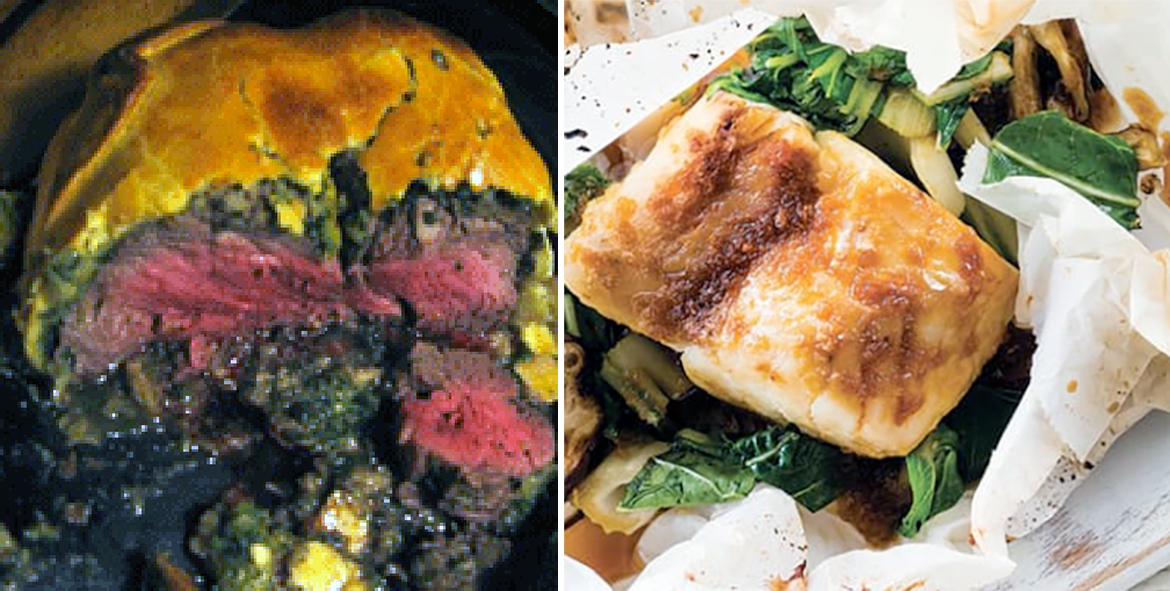FabulousFusionFood's Baking Recipes 11th Page
 A range of baked goods.
A range of baked goods.
Welcome to FabulousFusionFood's Baking Recipes Page — This is a continuation of an entire series of pages that will, I hope, allow my visitors to better navigate this site. As well as displaying recipes by name, country and region of origin I am now planning a whole series of pages where recipes can be located by meal type and main ingredient. This page gives a listing of all the baking recipes added to this site. Baking is defined as a technique for the prolonged cooking of food using dry heat by the action of conduction. Baking is normally done in an oven, but goods may also be baked in hot ashes or on hot stones. Baking differs from Roasting Recipes in that a lower temperature is typically used and the items are cooked for a longer period of time. Baking is a much older process than most people think and foods were probably originally baked in embers or with hot stones (which is how bread may have started). Only later did specialist ovens develop. Though most baked goods tend to be bread or cake-based some other dishes such as pasta dishes and vegetable dishes may also be baked. Stews are often also technically baked in an oven, but are not classed as 'baked goods' in that they are more liquid than solid at the end of the cooking process.
Baking is a method of preparing food that uses dry heat, typically in an oven, but can also be done in hot ashes, or on hot stones. The most common baked item is bread, but many other types of foods can be baked. Heat is gradually transferred "from the surface of cakes, biscuits and cookies, and pieces of bread to their centre, typically conducted at elevated temperatures surpassing 150°C. Dry heat cooking imparts a distinctive richness to foods through the processes of caramelization and surface browning. As heat travels through, it transforms batters and doughs into baked goods and more with a firm dry crust and a softer centre. Baking can be combined with grilling to produce a hybrid barbecue variant by using both methods simultaneously, or one after the other. Baking is related to barbecuing because the concept of the masonry oven is similar to that of a smoke pit.
In addition to bread, baking is used to prepare cakes, pastries, pies, tarts, quiches, biscuits and cookies, scones, crackers, pretzels, and more. These popular items are known collectively as 'baked goods', and are often sold at a bakery, which is a store that carries only baked goods, or at markets, grocery stores, farmers markets or through other venues.
 Beef en croûte (left) and fish en papillote (right).
Beef en croûte (left) and fish en papillote (right).
The alphabetical list of all the baking recipes on this site follows, (limited to 100 recipes per page). There are 2545 recipes in total:
Page 11 of 26
| Gâteau du Matin Breton (Breton Morning Cake) Origin: France | Gluecks-Schweinchen (German New Year Good Luck Pig Buns) Origin: Germany | Gratin Tatws a Bara Lawr (Potato and Laverbread Gratin) Origin: Welsh |
| Gâteau Michel (Michel's cake) Origin: Saint Pierre | Gluten-free Damson Plum Torte Origin: Germany | Greek Cheesecake (Myzithropita) Origin: Greece |
| Gateaux Piments (Chilli Cakes) Origin: Mauritius | Gluten-free Inverness Ginger Nuts Origin: Scotland | Greek Pita Bread Origin: Greece |
| Gavottes ou crêpes dentelle de Bretagne (Gavottes or Brittany Lace Crepes) Origin: France | Gluten-free Rhubarb Crumble Origin: Britain | Green Pistachio Muffins (Green Pistachio Muffins) Origin: American |
| Gebackene Quarktorte (Baked Quark cake) Origin: Switzerland | Gluten-free Rich Fruit Cake Origin: British | Green Tea Sponge Cake Origin: American |
| Gebne Mankoushe (Lebanese Cheese Pizza) Origin: Lebanon | Gluten-free Shortcrust Pastry Dough Origin: British | Green Velvet Cupcakes Origin: American |
| Gemmed Fairy Cakes Origin: Britain | Gluten-free Tea Scones Origin: Scotland | Griláž (Caramel Nut Wafers) Origin: Slovakia |
| Georgian Fruit Buns Origin: Georgia | Gluten-free Valentine Cupcakes Origin: Britain | Grilled Orange Roughy Origin: New Zealand |
| Gestowe Soetpatats (Slow-cooked Sweet Potatoes) Origin: South Africa | Gluten-free Vanilla Chocolate Cake Origin: British | Grissniuys (Beestings Pudding) Origin: Manx |
| Ghanaian Papaya Bread Origin: Ghana | Glykinai (Wine Cakes) Origin: Roman | Ground Elder Buns Origin: Norway |
| Ghrayba Origin: Libya | Goat's Cheese Muffins (Goat's Cheese Muffins) Origin: Britain | Ground Elder Pie Origin: Britain |
| Gibanica (Cheese Strudel Pie) Origin: Serbia | Gode Paest Origin: England | Ground Elder Quiche Origin: Britain |
| Gibraltar Caramel Flan Origin: Gibraltar | Godrogodro (Coconut Pudding with Vanilla and Sweet Spices) Origin: Madagascar | Grovey Cake Origin: Britain |
| Ginger Cake Origin: British | Golden Apple Pie with Rum Sauce Origin: American | Guava Squares Origin: Namibia |
| Ginger Fairings Origin: England | Golden Brioche Loaves Origin: France | Guiana Black Cake Origin: French Guiana |
| Ginger Nuts Origin: Britain | Golden Cinnamon and Musk Brioche Loaves Origin: France | Guinness Cake Origin: Ireland |
| Ginger Snap Biscuits Origin: Britain | Golden Cornbread with Calendula Petals Origin: American | Gulab Jamun Cheesecake Origin: India |
| Ginger Soy Fish en Papillote Origin: Fusion | Good Friday Fish Pie Origin: Britain | Gumdrop Fruit Cake Origin: Canada |
| Ginger Whisky Cake Origin: Scotland | Good Luck Chilli Biscuits Origin: Fusion | Gurnard Curry Origin: Britain |
| Ginger-chicken Pizza Origin: Fusion | Gooseberry and Almond Tart Origin: British | Guyana Black Cake Origin: Guyana |
| Gingerbread Easter Bunnies Origin: Britain | Gooseberry and Strawberry Tart Origin: Britain | Haggis in the Hole Origin: Scotland |
| Gingerbread Easter Bunny Biscuits Origin: Britain | Goosnargh Cakes Origin: England | Halibut with Pine Nut and Parmesan Crust Origin: Britain |
| Gingerbread Men Origin: Britain | Graham Crackers Origin: American | Halloween Cheesecake Origin: Britain |
| Gingerbread Mincemeat Cupcakes with Salted Caramel Icing Origin: Britain | Gram Flour Bread Origin: Anglo-Indian | Halloween Sugar Cookies Origin: American |
| Gingerbread Ring Cake Origin: British | Gramma Pie Origin: Australia | Halupki (Stuffed Cabbage Rolls) Origin: Slovakia |
| Ginseng Banana Muffins (Ginseng Banana Muffins) Origin: American | Grapefruit Cake Origin: New Zealand | Halupki Stuffed with Buckwheat Groats Origin: Slovakia |
| Glacé Icing Origin: Britain | Grasshopper Cheesecake Origin: American | Ham and Broccoli Stuffed Potatoes Origin: Ireland |
| Glazed Canella Scones Origin: Britain | Gratin Christophine (Chayote Gratin) Origin: Guadeloupe | Ham and Haddie Pie Origin: Scotland |
| Glazed Easter Biscuits Origin: Britain | Gratin Dauphinoise Origin: France | Hapalos Artos (Soft Bread) Origin: Roman |
| Glazed Lemon Cheesecake Origin: American | Gratin de Couac (Couac Gratin) Origin: French Guiana | Hareless Potpies Origin: British |
| Glazed Orange Cheesecake Origin: American | Gratin de fruits de mer (Seafood Gratin) Origin: Monaco | Hart rows Origin: England |
| Globi (Fried Cheese and Poppy-seed Balls) Origin: Roman | Gratin de galettes aux crevettes (Gratin of Pancakes with Prawns and Mushrooms) Origin: France | Haselnußtorte (Hazelnut Torte) Origin: Germany |
| Gloucestershire Cheese and Ale Origin: England | Gratin de Morue (Salt Cod Gratin) Origin: Mauritius | |
| Glücksbringer (Lucky Charm Biscuits) Origin: Germany | Gratin de pommes de terre des Antilles (Antilles Potato Gratin) Origin: Guadeloupe |
Page 11 of 26